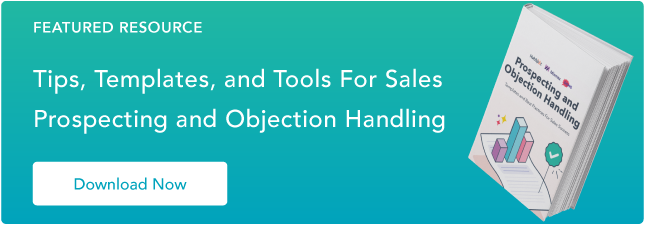Imagine the following: You’re talking to a random stranger, but they keep looking at their watch. They’re clearly not listening, and when the conversation is finished, you feel like you’ve effectively wasted your time.
That’s what selling without prospecting is like.
Prospecting ensures that every lead you talk to is genuinely a good fit for your product — or has the potential to be a good fit. While you won’t know for sure until you carry out the lead qualification process, you can save a significant amount of time by researching potential buyers before writing a single email line or making a single phone call.
The truth is, sales is changing — quickly. As sales conversations grow even more buyer-focused, sales reps have begun developing hacks, techniques, and processes for prospecting.
And that’s where this guide comes in. In this growing sales landscape, we’ll outline the various processes and key strategies for sales prospecting — the phase of selling that often consumes the most time and energy and is the most crucial to get right.
Let’s start with a quick refresher.
Why is sales prospecting important?
Prospecting allows you to identify good-fit customers for your business. This means finding leads who truly need your product or service to solve their challenges and pain points.
It’s extremely effective, too. More than 7 in 10 buyers actually want to hear from salespeople early on in the buying process, making it more likely that they’ll respond. In fact, 82% of buyers accept meetings when a salesperson reaches out first.
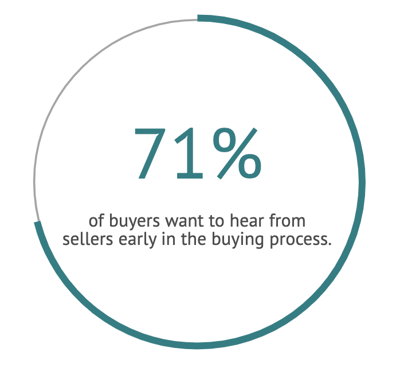
Salespeople who are top performers in the act of prospecting generate nearly 3X more sales meetings than those who are “low” performers — or those who don’t prospect at all.
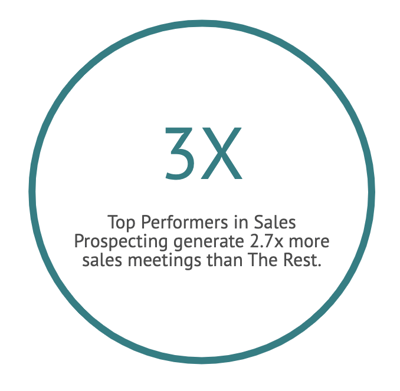
Once you finish prospecting, you’ll have meetings with leads who are a much better fit for the product. Good-fit customers provide long-term business and value versus leads who churn after closing a deal. You can identify good-fit customers while prospecting by asking the right sales qualification questions to all of your leads and prospects.
Speaking of leads and prospects, it’s important to note the differences between these two types of people. You and the rest of your sales team will be communicating with them during prospecting — and knowing who’s who will affect how you approach them.
Let’s take a look.
Lead vs. Prospect
Leads are potential customers who’ve expressed interest in your company through behaviors like visiting a website, subscribing to a blog, or signing up for a free trial. Prospects are leads that are qualified and, therefore, align with your target audience and buyer personas.
Depending on their qualifications and fit, a prospect (not a lead) can be classified as a potential customer even if they have had limited or no interaction with your company.
It’s also important to remember that although leads and prospects differ by definition, your goals with both are the same: Nurture leads and prospects until they buy your product or service. This nurturing process begins the moment you start prospecting and up until the time you close the deal.
But how do you even begin prospecting? Below, we’ve put together a simple guide for getting started. We’ll then cover some proven tips for finding good-fit prospects who will be more likely to close.
Unproductive prospecting is a huge time-waster. That’s why we recommend the inbound way and put together a basic framework that applies to all sales processes. But with a twist.
We understand that everyone has their approach. So we’ve also weaved in personal prospecting tips and tricks from the best salespeople we know. Pick and experiment with whatever works best for your own sales hustle.
1. Research your prospect and their business to gauge whether you can provide value.
We’ll go over this again and again in this post — that’s because this is by far the most important aspect of prospecting. We must ensure that we’re qualifying our prospects to improve our chances of providing value to them or their business.
In this stage of prospecting, we’re looking to accomplish a few goals:
Determine if the prospect is workable.
Qualify and begin prioritizing prospects.
Find opportunities to develop a connection through personalization, rapport building, and trust development.
2. Prioritize your prospects based on their likelihood of becoming a customer.
Prioritizing our prospects can save us time and ensure we’re dedicating our strongest efforts to prospects that are most likely to become customers.
Levels of prioritization will vary between each type of sales organization and each salesperson, but the main idea is to create a few buckets of prospects based on their likelihood to buy and focus on one bucket at a time.
Let’s break down the qualifying dimensions used in our list above (and any additional relevant dimensions) into percentages between 1% and 100% based on how important they are to the sales process.
For example, the size of the opportunity is probably more important to us than timing in terms of closing a deal, so it would receive a 70% whereas timing would receive a 5%.
Now we can assign a value between 1 and 100 to these dimensions for each prospect in our list. Once we complete this step, we can multiply each prospect’s value by the percentage weight we gave to the dimension.
Add up these dimension scores until each prospect has a total score. And now our entire list is prioritized.
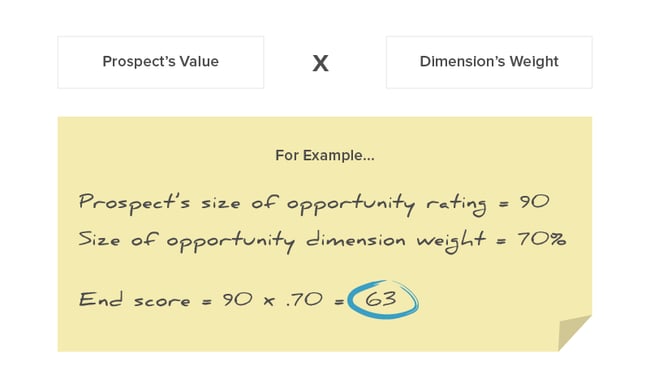
Note: Lead management software does this automatically.
3. Prepare a personalized pitch for each prospect.
In this step, we’ll gather in-depth information on our prospects to hone our pitch and personalize our outreach. So first, we must determine what our prospects care about.
We can do this in a few ways:
Take a look at the prospect’s blog to learn what they care about through the articles they’re writing and publishing.
Identify and review their social media profiles. Do they have recent updates or new posts?
Check the company website to review their “About Us” information.
Once we’ve learned more about our prospect’s business and role, we need to find a reason to connect. Do we have mutual connections? Has there been a trigger event? Have they recently visited our website? If so, which search terms drove them to our site? Which pages did they look at?
If we want to get more high-level with our prep, we can create a decision map to outline our prospect’s options and end-goals. This will help us better handle any objections and personalize a pitch that resonates with their primary objectives.
We could also conduct a competitive analysis to determine how we can better position our company’s service or product within the industry and how we can combat prospects’ objections.
4. Craft the perfect first touch — and ensure you’re helping, not selling.
Whether calling or emailing, our outreach should be highly tailored to our prospect’s particular business, goal, and industry.
Keep these general tips in mind when contacting a prospect, whether on the phone or through email:
Personalize. Reference a specific problem that the prospect is encountering with a specific solution.
Stay relevant and timely. Ensure the issue a prospect is trying to solve is still relevant to them and their team.
Be human. No one likes to communicate with a professional robot. Adding in details like wishing someone a happy holiday weekend or by conveying how awesome their company’s product is are real touches that allow us to establish a connection on a deeper level.
Help, don’t sell. Provide value and ask for nothing in return. This process isn’t about us, it’s about them. For example, instead of scheduling a follow-up meeting, we could offer to conduct an audit on their digital media presence and get back to them with our findings in a week.
Keep it casual. Remember that this is just a conversation. Stay natural and as not salesy as possible. The key to prospecting is that we’re never selling. We’re simply determining if both parties could mutually benefit from a relationship.
5. Iterate on your prospecting process to understand what you can improve.
Keep notes throughout this process to assess what activities generated value for the prospecting process and which wasted time.
After each contact with a prospect, we should assess how well we:
Uncovered challenges
Helped create well-defined goals
Confirmed availability of budget
Understood the decision-making process
Determined consequences of inaction
Identified potential results of success
This self-reflection will help us improve our sales prospecting techniques in the future.
Now, let’s look at a few tips straight from the sales desk on how to better qualify prospects and win more deals.
1. Look at your prospects’ career pages.
Look at the business’ job board to find departments in which they are investing or growing. This can further inform us of their key goals or challenges.
If our prospect is a public company, we can also look at their annual financial report (dubbed a 10-K) under the “Risk Factors” section to see if there’s alignment between their stated business challenges and our product offering.
2. Use the GPCTBA/C&I sales qualification framework.
There are a “bajillion” sales qualification frameworks. At HubSpot, the reps have coined the GPCTBA/C&I framework (which they vouch sounds more confusing than it is).
The acronym stands for:
GPCT (Goals, Plans, Challenges, Timeline)
BA (Budget and Authority)
C&I (Negative Consequences and Positive Implications)
Here is the basic breakdown and some examples of questions asked when connecting with potential customers to follow the framework:
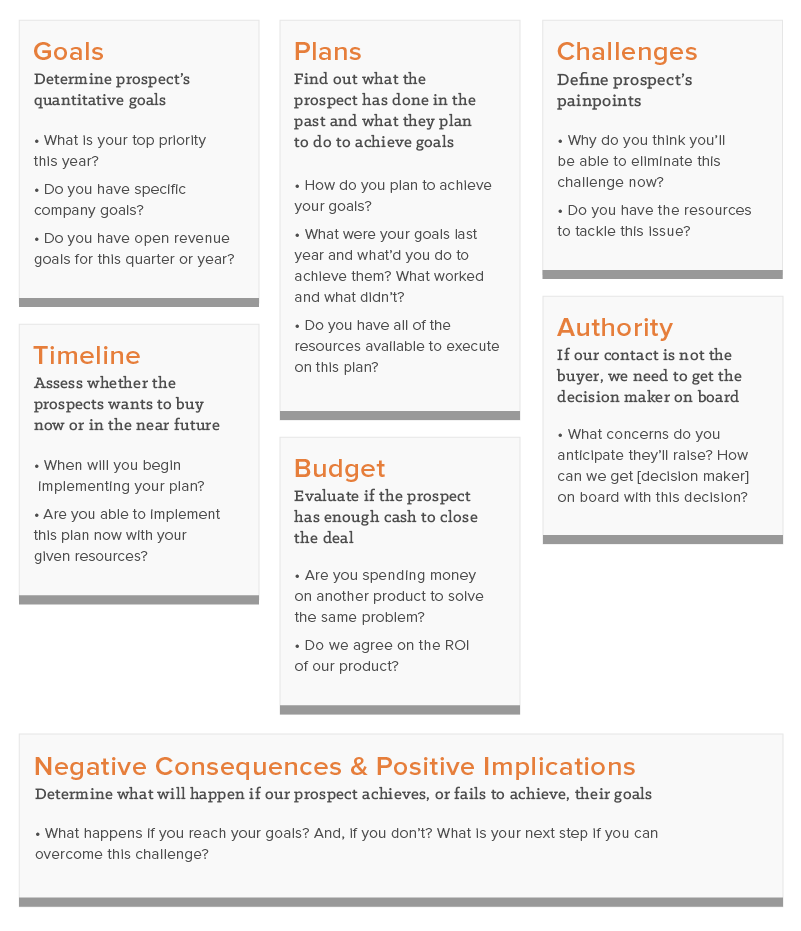
Now we can focus on creating a highly targeted, relevant list. Based on our research, we should have a fine-tuned profile of our target customer, and every company or individual on our prospect list should meet those criteria.
3. Classify prospects with ratings.
Qualitatively classify prospects by rating them on a spectrum from high, medium, and low suitability. Here’s what that looks like:
High
Matches criteria for customer persona
Clear business challenge that aligns with our product offering
Able to connect with a decision-maker
We have a mutual connection or common interest (i.e. mutual friend on LinkedIn or both graduated from the same college)
High level of interaction with our website or social media accounts
Recommended effort: Five touchpoints every other business day
Medium
Match some elements of our customer persona
Clear business challenge that aligns with our product offering
Able to connect with an influencer
Some level of interaction with our website or social media accounts
Recommended effort: Four touchpoints every other day
Low
Doesn’t match with our customer persona
Unclear business challenge
Not able to connect with an influencer or decision-maker
Limited or no interaction with our website or social media accounts
Recommended effort: Three touchpoints every other day
4. Subscribe to your prospects’ blogs.
Kyle Van Pelt, Executive Vice President of Sales at Skience, reads 30 articles in 30 minutes every day and uses the content in his email outreach in a tailored, relevant way. And he achieved a 90% response rate.
Kyle uses Digg to subscribe to the companies’ blogs he thinks would make for good prospects.
Here’s how it works:
Open each interesting post in a new tab.
Skim each post.
Read the most interesting posts.
After skimming through all of the options, narrow the final list down to the most interesting posts. There will typically be between 20-30 posts left. We should put ourselves in the prospect’s shoes as we’re reading these articles, searching for pain points or trigger events.
Use the most interesting, relevant information we find in the articles to tailor an email or a call to our prospect.
All of these questions will help us craft more context around our prospect’s situation, which will help us when we’re ready to make that initial contact.
5. Keep track of your prospects on Twitter.
Everyone’s on Twitter — including your prospects. Create a list of top priority prospects on Twitter to more easily track trigger events and streamline the research process. Here’s how to set it up on Twitter’s mobile app:
Click your profile picture in the upper left-hand corner, and then click “Lists.”
Now click the blue button with a list icon and a plus sign on the bottom right-hand corner
Name the list and then set it to “Private” so only you can access it.
Now add the prospects you want to track to your list. Just search for their accounts and click the button that says “Add.” Note: You may want to group your high-priority prospects in one list, followed by your medium-priority prospects, and then low-priority.
Now that you’ve created the list, we can easily monitor our prospects’ activity using a tool like HubSpot Social Inbox. HubSpot’s Social Inbox color-codes your customers and leads and helps you prioritize your engagement. You can see what type of content resonates with your prospects by tracking their interactions, conversations, and new follows.

Now we can focus on creating a highly targeted, relevant list. Based on our research, we should have a fine-tuned profile of our target customer, and every company or individual on our prospect list should meet those criteria.
Watch as this feed populates with prospect activity. We can check this every morning and afternoon to see if any trigger events have occurred that would provide a valuable opportunity for us to connect.
6. Batch prospecting sessions.
Batch prospecting sessions for 2 to 3 hours at a time and take a quick five-minute break between each hour. Get an egg timer, and set the timer on a countdown for 20 minutes, 30 minutes, or 45 minutes, depending on how much time we scheduled for the call.
End the call on the timer’s beep, use 5 minutes for following up, 5 minutes for updating notes and administrative tasks in your CRM, and then use 5 minutes to prep for the next call.
7. Use a healthy mix of email and phone communication.
In terms of establishing contact, we must decide between email or phone communication. Some of us will initially jump on the cold email approach while others will dive into the cold call. This strategy will vary based on what each salesperson feels most comfortable with.
First, let’s take a look at the pros and cons of email communication:
Email communication Pros
Email communication Cons
Emails are visual and allow prospects to consider the offer on their time.
Email is a cluttered space so it may be harder to grab a prospect’s attention.
Emails provide prospects with adequate time to research the company and product.
They’re easily deleted or forgotten.
They’re easily forwarded to key stakeholders who might be a better fit to speak with.
We may have to follow up multiple times before we get a response.
Now, let’s look at the pros and cons of phone communication:
Phone communication Pros
Phone communication cons
Calls are less common than email, so they can grab a prospect’s attention quickly and more easily.
Some prospects may feel overwhelmed by a call and thus be less inclined to consider a pitch or schedule a second meeting.
They immediately establish a more intimate connection and offer salespeople the chance to develop rapport.
While intimate, calls can be seen as intrusive, especially when unscheduled.
They’re often more timely than email communication and can accelerate the time it takes to close a deal.
There’s no guarantee a prospect will pick up the phone. Voicemail can often be as cluttered as email depending on volume.
Successful first touch strategies often incorporate both approaches to take advantage of the pros and minimize the cons.
8. Use the BASHO sequence for emails and calls.
Jeff Hoffman pioneered the BASHO sequence, which advocates a combination of voicemail and email messages to gain leverage with prospects.
Voicemail / Email: Wait for 24 hours
Voicemail / Email: Wait for 48 hours
Voicemail / Email: Wait for 72 hours
Voicemail / Email: Wait for 5 days
Breakup Voicemail / Email
Alternating between voicemail and email, with unique messaging each time, this technique allows prospects to consider our offer, conduct their own research, and respond at a time convenient for them.
But how do we leave a voicemail or send an email that prospects want to respond to? Let’s dive into the dos and don’ts of each communication method below.
The Warm Email
If we’re looking to send a first-touch email that gets opened, there’s some essentials that we must include:
Engaging subject line: The subject line has to pique the prospect’s interest while avoiding cliché hooks.
Personal opening line: We should begin our cold email by saying something about them, not about us. After all, this process is about finding the prospect’s pain points and determining a way to add value to their business or processes.
Creating a connection: Now we have to make the connection. In our opening, they learn why we’re reaching out to them, but now they need to know why they should care about what we do.
Clear call-to-action: Suggest a concrete time to connect or ask a close-ended question to make it clear that the ball is in their court. Try using one of these lines: “Do you have ten minutes to catch up tomorrow?” or “Are you available for a 30-minute call on Tuesday between 9 and 11AM?”
Try sending a calendar invite, instead of an email, to get straight to the point. In the description section, we can type up a personalized message like this:

Jill Konrath also suggests scheduling a short 5-minute meeting to get our foot in the door with prospects whose calendars are particularly swamped.
The Prospecting Call
If we decide to call a prospect, whether in conjunction with an email or not, we can follow this basic structure for the call:
Establish rapport: We shouldn’t shy away from personal conversations, like asking how a prospect’s weekend was or what team they’re rooting for in the game tonight. These intimate touches help us develop a more meaningful relationship with prospects and enhance our likeability which, hopefully, means a prospect will be more likely to buy from us.
Leverage pain points: Dive into their pain points during the call. By the end of the conversation, we should know all of their primary business challenges and the underlying causes associated with them. Once we have an understanding of these key issues, we can better position our product or services to solve them.
Create curiosity: Ask questions about their business. Ask more than tell. This conversation is about them and understanding their needs and problems. The less we talk about our business and product, the more our prospect will be interested to hear the final pitch.
Wrap it up: Find a calendar time between 24-48 hours after the discovery call to book a follow-up meeting. Try this line: “Would you have 30 minutes to follow up this week? My colleague, John, will join us — he’s an expert in X, Y, Z. My calendar’s open, what works best for you?”
9. Follow-up after a closed-lost deal.
Bryan Kreuzberger, founder of Breakthrough Email, sends a follow-up email if prospects respond with a rejection. The purpose of this email is simple: Learning. We can use this rejection as an opportunity to better understand how we can improve our sales techniques by sending this template:
Hi [prospect name],
Thanks for your email. I just closed your file. I have a quick question as a final follow up. Why aren’t you interested? Was it something I did?
If there is any way I can improve, let me know. I’m always looking for input.
Thanks for your help,
[Name]

One of HubSpot’s sales managers uses Gmail labels to visualize his prospects as they move through the flywheel.
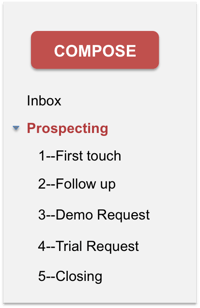
For example, after an initial discovery call, he sends a follow-up to his prospects and labels their response according to the action required. This allows him to easily shift gears when contacting cold prospects versus re-engaging old prospects or moving warm prospects further down the funnel.
With all of the steps and tricks involved in the prospecting process, we can often find ourselves spending too much time on menial tasks. Luckily, we can use sales prospecting tools to boost productivity and automate tasks.
You can select specific tools from this list to use independently or in tandem with each other. Consider which tools you currently use for prospecting to determine your needs and gaps. Then, experiment with the options below to discover which ones work best for your business.
1. HubSpot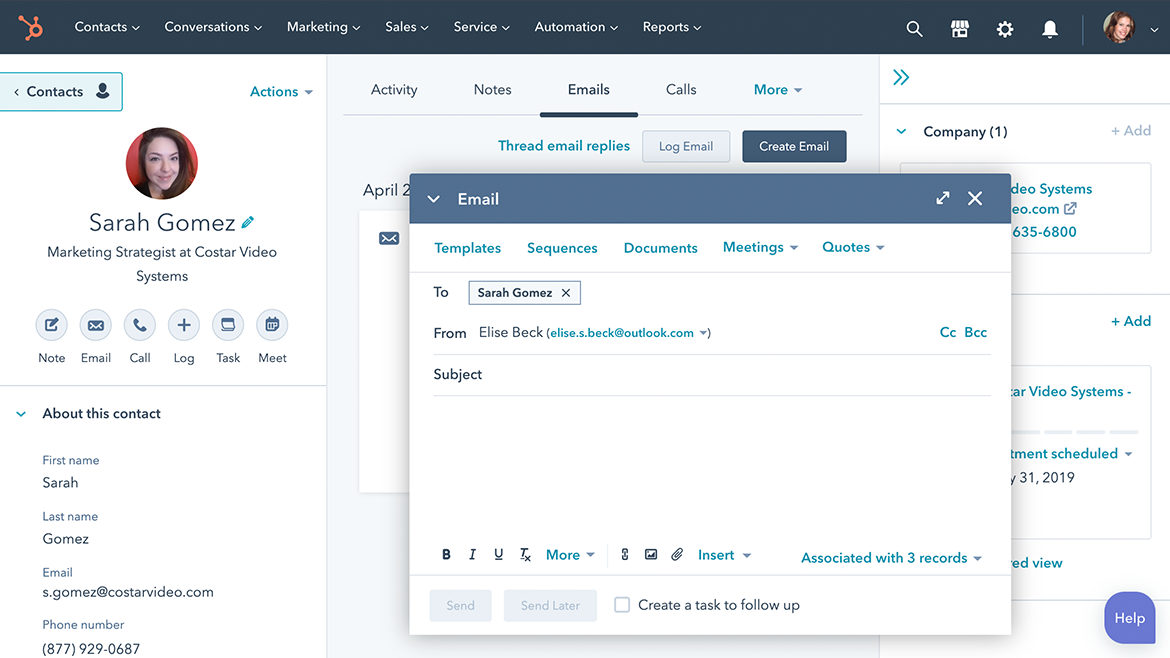
HubSpot allows you to keep track of sales activity and source new prospects. Manage your sales pipeline, automatically log all rep activity, keep information about all of your contacts in one location, and chat with those contacts in real-time. You can even call those prospects directly from the CRM to streamline all communication.
How to use it: The CRM helps surface warm prospects who have already visited your website. Store contacts and companies, track deals, and easily manage tasks such as follow-ups and meetings. You can also make the process of nurturing your customers easier by sending them personalized email sequences. Then measure the success of your email templates directly within the CRM.
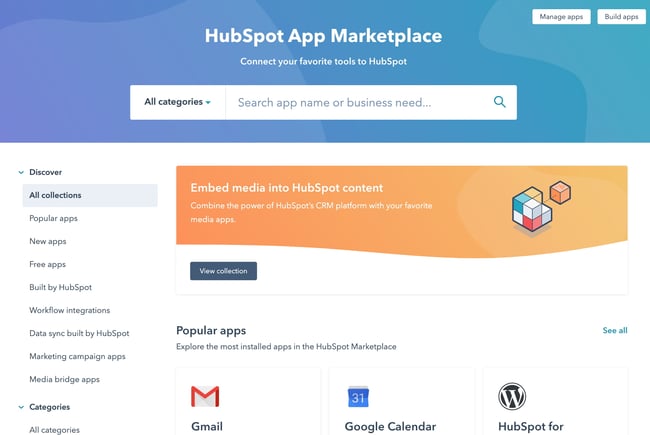 Connect your CRM and HubSpot account to web apps you use to automate tedious prospecting tasks. Pick and choose from the hundreds of apps within the HubSpot Marketplace — many of which are specifically meant for sales teams — that will help reps work efficiently and effectively.
Connect your CRM and HubSpot account to web apps you use to automate tedious prospecting tasks. Pick and choose from the hundreds of apps within the HubSpot Marketplace — many of which are specifically meant for sales teams — that will help reps work efficiently and effectively.
How to use it: Search the application marketplace to connect the apps and web services you use every day to your HubSpot account. Review the sales apps specifically for options that will help you simplify whatever it is your team is struggling with most.
3. Sales Hub
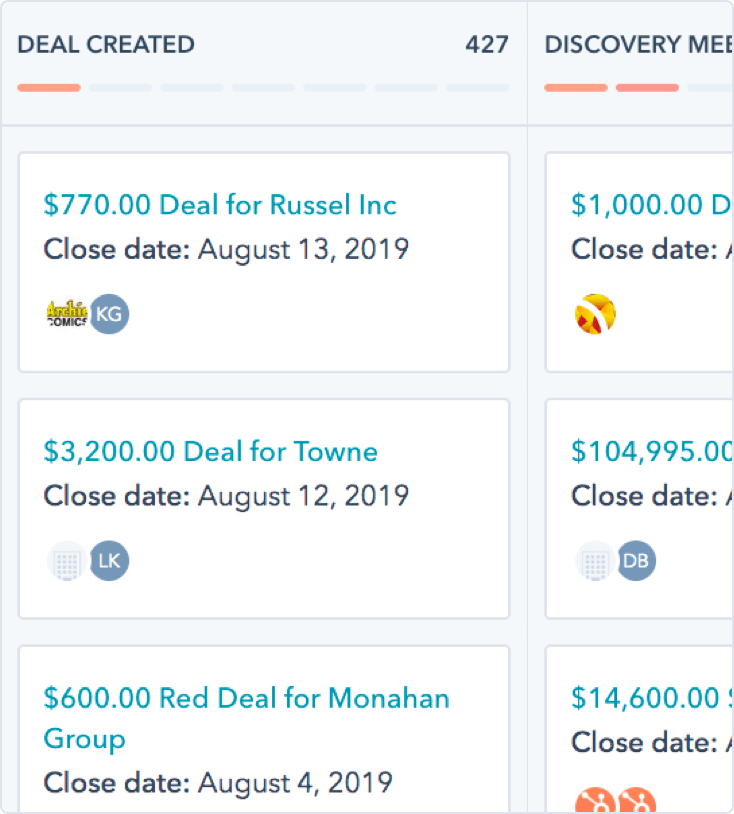 Use email tracking to know when prospects open emails, click on links, or open attachments. Sales Hub also provides detailed contact information right in your inbox and allows you to schedule emails to be sent when you know your prospect will be most likely to open them.
Use email tracking to know when prospects open emails, click on links, or open attachments. Sales Hub also provides detailed contact information right in your inbox and allows you to schedule emails to be sent when you know your prospect will be most likely to open them.
How to use it: If we see that a prospect is viewing an email we sent two weeks ago, we can follow up with information related to what they’re viewing, or email them to set up another meeting.
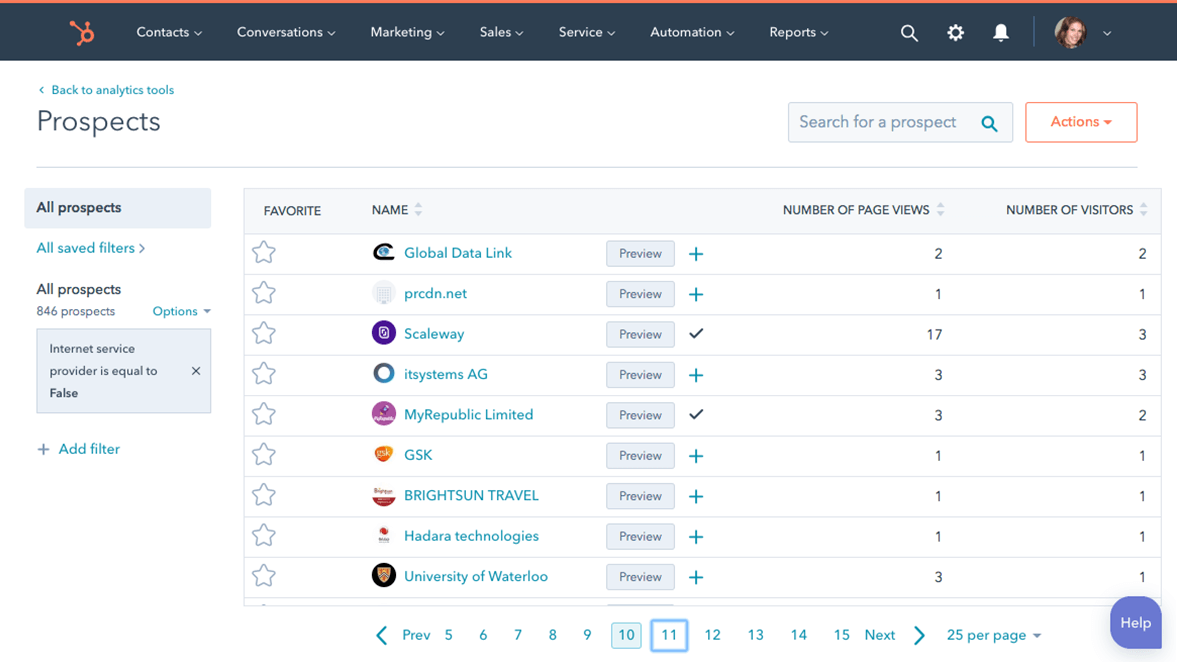 With HubSpot’s prospects tool, you can track all visits to your website in real-time. The tool makes it easy for you to determine which people are engaging most frequently with your site so you know who to follow-up with.
With HubSpot’s prospects tool, you can track all visits to your website in real-time. The tool makes it easy for you to determine which people are engaging most frequently with your site so you know who to follow-up with.
How to use it: Customize email notifications for reps on your team. Use filtering criteria, such as location and company size to easily identify and organize your prospects. You can also set up regular email digests and notifications for the prospects that matter most to you and the reps on your team.
5. SalesHandy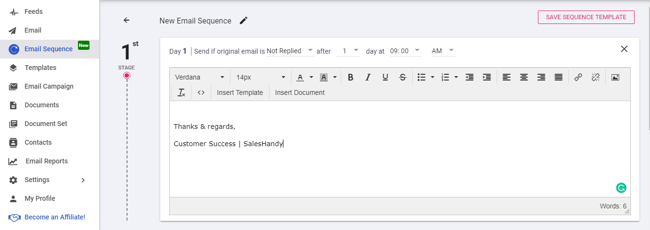
You can automate your lead nurturing sequence by scheduling outreach emails using SalesHandy. This tool allows you to automate up to nine stages of follow-ups to all recipients who haven’t opened or replied to your initial email.
How to use it: Use email campaigns to reach out to new leads and prospects. Once you get notified regarding their email opens, you can follow-up automatically and nudge them to respond. Email tracking lets you know how many times, and when your emails were opened, so you can gauge their interest and move them to the next stage of your funnel.
6. Twitter
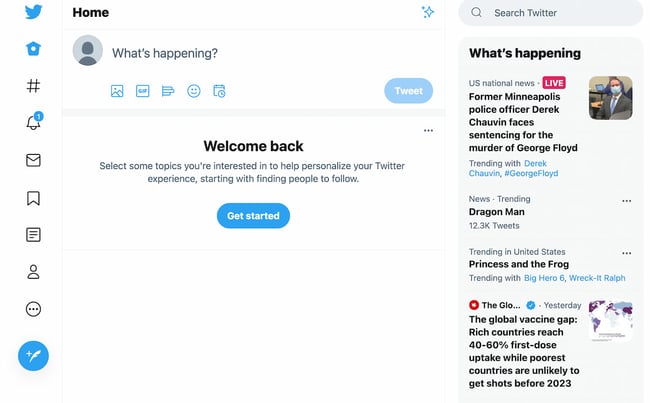 We can use Twitter to get an idea of what our prospect finds important. By showing them support through a retweet or favorite, or even engaging them in conversation, we can show them that we have their interests, challenges, and needs in mind. Because we’ve already opened the relationship through a personal medium like Twitter, we’ll have a greater window of opportunity to adjust our pitch.
We can use Twitter to get an idea of what our prospect finds important. By showing them support through a retweet or favorite, or even engaging them in conversation, we can show them that we have their interests, challenges, and needs in mind. Because we’ve already opened the relationship through a personal medium like Twitter, we’ll have a greater window of opportunity to adjust our pitch.
How to use it: To inform the sales process, use Twitter’s Advanced search to quickly sift through a prospect’s feed and find what’s important. For example, if we see that a prospect posted a question about our product, it’s a perfect opportunity to respond.
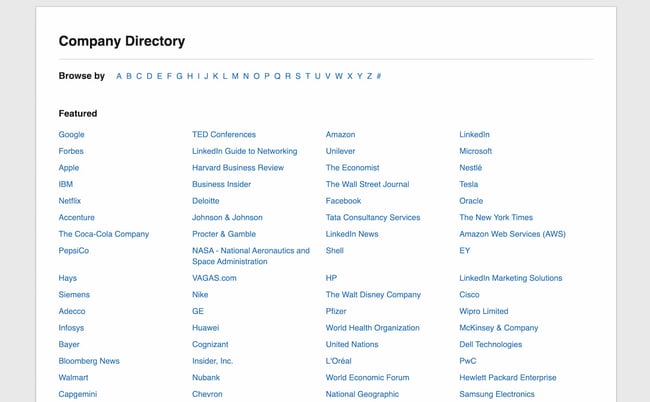 This provides us with a feed on the company’s recent updates to help discover industry news, marketing campaigns, events, product launches, and recently published content.
This provides us with a feed on the company’s recent updates to help discover industry news, marketing campaigns, events, product launches, and recently published content.
How to use it: We can reference these updates as trigger events to engage our prospects in real conversations. You can also use this tool to find key stakeholders and decision-makers.
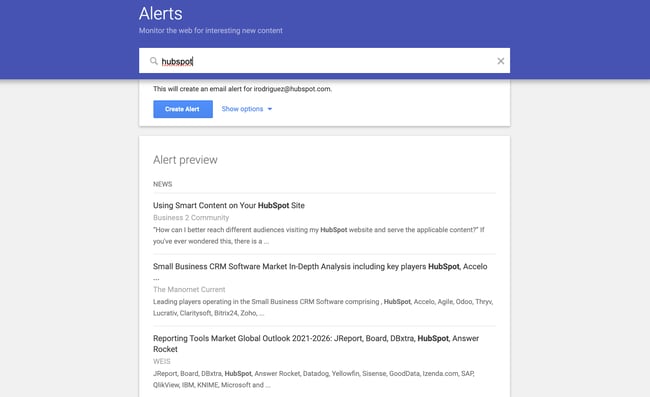 Google Alerts allows us to track web mentions on a company’s name, product, competitors, or industry trends.
Google Alerts allows us to track web mentions on a company’s name, product, competitors, or industry trends.
How to use it: Customize alerts to send real-time, daily, weekly, or monthly updates on whichever keywords are relevant to our prospects. We can use these to tailor our outreach.
9. Datanyze
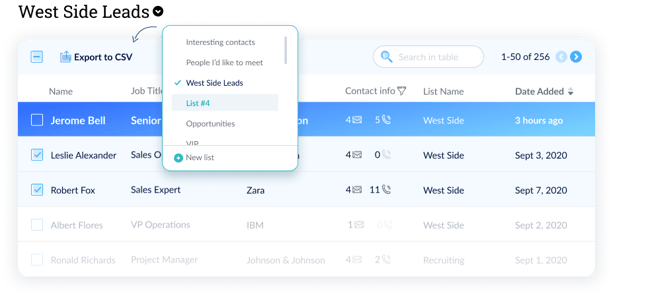 Datanyze tracks competing technology providers and informs us of companies who have started or stopped using its solution.
Datanyze tracks competing technology providers and informs us of companies who have started or stopped using its solution.
How to use it: Connect with prospects after they stop using a competitor’s product to catch them while they’re on the market for a better offering.
10. FoxClocks
 This is an extension for Chrome and Firefox that lets us keep track of local or foreign time zones in our status bar.
This is an extension for Chrome and Firefox that lets us keep track of local or foreign time zones in our status bar.
How to use it: Manage your prospects in multiple cities and countries and never miss a meeting due to a misunderstanding between PST, EST, CT, or even international time zones.
11. Evernote
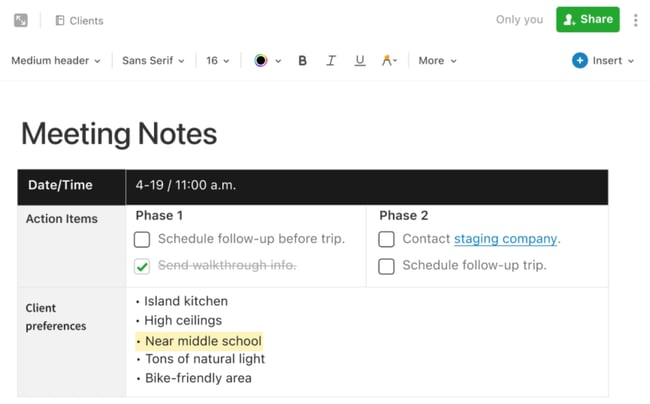 Stay organized and efficient by taking notes in Evernote, which syncs notes through their mobile, desktop, and web apps.
Stay organized and efficient by taking notes in Evernote, which syncs notes through their mobile, desktop, and web apps.
How to use it: Use this tool while on an exploratory prospecting call to keep track of pain points, company details, and action items.
12. Kixie
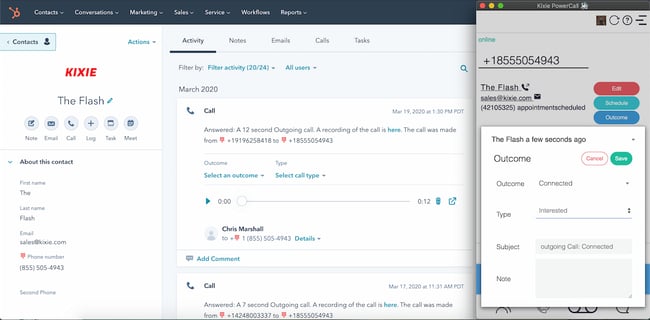 Kixie is a sales prospecting application you can integrate with HubSpot. It uses artificial intelligence (AI) to help you connect with more prospects.
Kixie is a sales prospecting application you can integrate with HubSpot. It uses artificial intelligence (AI) to help you connect with more prospects.
How to use it: Use the full-voice and SMS enterprise phone platform to assist with your voicemails, create a virtual receptionist, and transfer calls. Integrate it with HubSpot and create sales cadences, automatically log all of your communication with prospects, and trigger your HubSpot Workflows during or after calls.
Now that you’re prepared with the guidance, tips, and tools you need, let’s take a step back and look at the sales prospecting process as a whole.
Sales Prospecting Process
We’ve decided whom to pursue. It’s time to get even more granular and jumpstart the nurturing process, which will ideally result in a closed-won deal. Regardless of what your sales pipeline looks like, you’ll typically go through the following phases.
1. Research
Effective prospecting begins by further researching the prospects whom we’ve determined are generally a good fit. Our goal during this phase is to determine the quality of the prospect — whether, based on their challenges and budget, they’re likely to make a purchase.
We’ll do this by evaluating the prospect using preset qualifying dimensions and keeping track of our findings through a CRM.
Qualifying dimensions: A set of criteria to evaluate the probability that a lead or prospect will become a customer.
CRM (customer relationship management): Software that allows companies to keep track of their potential and existing customers at whichever stage they may assume in the sales cycle.
2. Outreach
Once we’ve qualified the prospect, it’s time to reach out to someone at the business. Or, if we’ve already found a person whom we’d like to reach out to, we’ll reach out to them directly using a sales prospecting email.
We’ll come across one type of person at this stage: a gatekeeper who guards the way to a decision-maker.
Gatekeeper: Person in charge of communicating or preventing information from reaching a decision-maker; for example, receptionists or personal assistants.
Decision-maker: The person in charge of making a final decision on the sale. We usually have to go through a gatekeeper to reach them.
3. Discovery Call
Once we’ve reached a gatekeeper, it’s time to schedule the next meeting: a discovery call. By asking the right questions during the discovery call, we’ll get to know the prospect’s unique challenges and get more acquainted with their business.
Discovery call: The first contact a sales rep makes with a prospect to qualify them for the next step in the sales cycle.
4. Educate and Evaluate
After a discovery call, it’s time to evaluate and qualify the needs of the prospect. This is key because it can show us just how much the prospect needs the product to meet their business goals.
We’ll look at two things during this phase:
Pain point: A prospect’s business need; this is what sales reps must identify to provide value and move them farther along in the sales cycle.
Objection: A prospect’s challenge that keeps them from purchasing a product or service, e.g. budget or time constraints.
5. Close
We’ve got all the information we need. We know the prospect’s challenges, pain points, and possible objections to purchasing the product. It’s time to turn them into customers by convincing them of the value they’re getting. This will result in one of two outcomes:
Closed-won: When the buyer purchases a product or service from the sales rep.
Closed-lost: When the buyer fails to purchase a product or service from the sales rep.
From these two numbers we can calculate our closing ratio, or the ratio of prospects that a sales rep closes and wins.
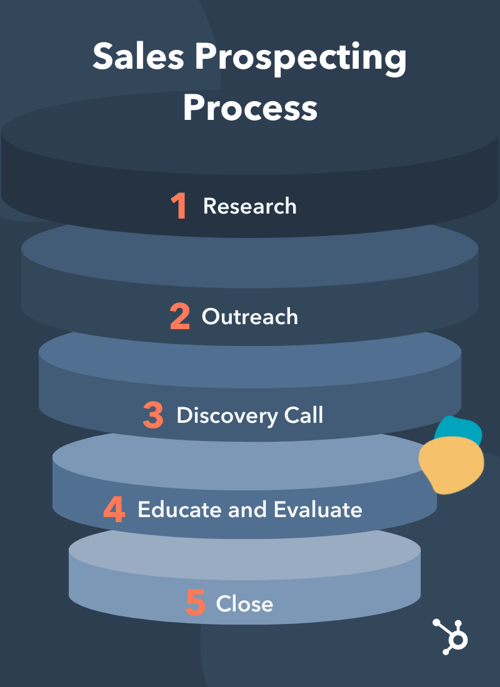 As you move through the process, you can typically engage with prospects one of two ways: either through outbound or inbound prospecting.
As you move through the process, you can typically engage with prospects one of two ways: either through outbound or inbound prospecting.
Outbound vs Inbound Prospecting
As the sales environment matures, we’re seeing a shift in how prospecting is done. Sales reps no longer have to choose between inbound or outbound prospecting. Instead, they must decide how to do both responsibly.
Outbound prospecting is when you reach out to leads who haven’t yet expressed an interest in your product or business. You typically identify prospects through independent research — by finding them via LinkedIn, Google, or another platform.
Inbound prospecting is when you reach out to a lead who shows an active interest in your business or product. They’ve visited your website, subscribed to your blog, and maybe even submitted a form asking to speak to a sales rep. You then engage with them to understand whether they’d be a good fit for the product.
Here are the key differences in the two methodologies.
Outbound prospecting
inbound prospecting
Outreach
Cold calling or emailing — unsolicited calls to sell a product or service
Warm emails to explore a relationship with a lead who has already expressed familiarity with your product or service
Social “spamming”
Unsolicited social media messages to sell a product or service
Using social media to explore a relationship with a lead who has already expressed familiarity with your product or service; sales reps can provide value to prospects on social media by answering their questions and introducing them to useful content
Process
Research takes longer without any prior history with a contact — less context for us when we’re ready to reach out to establish a connection
Research process is shorter as we already have their contact information and interaction history — it provides us with context about the prospect’s interests or prior behavior, allowing us to develop more personalized outreach
Example
“Hi John, I wanted to reach out to you because I’ve worked with companies similar to yours in the past.”
“Hi John, I’m reaching out because I noticed you were looking at our e-book on improving sales productivity.”
Our recommendation? Use the inbound methodology, with a responsible approach to outbound tactics like cold calling and cold outreach. This last piece is especially important for businesses who don’t have enough qualified inbound leads.
Before a salesperson even has a chance to contact a prospect, he or she is already over half of the way through the sales process. It’s time companies and sales reps start helping the buyer rather than selling to them by leveraging their context and understanding who they are and what they need.
But how do you do that? How do you find prospective buyers and learn the context surrounding their business needs? Even more importantly, how do you determine whether or not you should begin the process of selling to them?
You’ll do this by asking a few basic sales prospecting questions.
Sales Prospecting Questions
Knowing who to pursue saves us a significant amount of time. Not every lead is fit to be a prospect, and not every prospect will become a paying customer. Luckily, you can ask a few questions that can help you determine whether a prospect is worth pursuing.
Even if we use outbound prospecting methods, we should see a much better response rate because we took care to vet their business for suitability.
Below are some qualifying questions and related takeaways to help you evaluate whether or not a prospect has a high probability of becoming a customer.
Is the prospect’s business an organizational fit?
This type of qualification is based solely on demographics. Does the prospect fall within my territory? Do we sell in their industry? Does it fit our buyer persona?
Say our target market consists of small- to medium-sized businesses with anywhere from 100 to 1,000 employees. We should eliminate any potential customers outside of these criteria.
Diving deeper, our product or service will naturally provide higher value to a particular profile within that target market. For example, medium-sized businesses consisting of a larger team. Those customers are also more likely to upgrade to a higher tier of our product, providing more lifetime value as a customer.
Takeaway: Prioritize customers based on the size of the opportunity or their potential lifetime value.
Have you identified key stakeholders?
There are two types of people involved on the other end of our sales process: Decision-makers and influencers.
Influencers may not have the power to buy, but they’re often the ones that will be using the product and thus can become our biggest internal advocates. If we get them to rally around our offering, they can make a compelling case to decision-makers before we even speak with them.
Decision-makers are, of course, the ones that either approve or reject the buy. We can ask these questions to determine the decision-making process: Will anyone else be involved in this decision? Does this purchase come out of your immediate budget?
Takeaway: Keep a working list of influencers and buyers, perhaps mapped out by the organizational structure of the organization. We’ll use this list later in the outreach phase of prospecting.
Are the prospect’s constraints a deal-breaker?
Time constraints and budget limitations are often the biggest objections we receive from prospects. Before wasting time on an exploratory call to hear this objection, let’s do some homework beforehand to see if we can filter out potential buyers who clearly don’t have the bandwidth to consider our offering.
Takeaway: If we see a prospect has just launched a new marketing campaign, they might not have the time to cycle through an extensive sales process. We should take note of prospects who clearly have their hands tied and revisit them at a later date.
Do you have familiarity with the prospect’s market?
We’re likely to be more familiar with certain types of companies, markets, or industries than others. Our pitch and sales techniques are also likely to be more refined with markets we feel comfortable talking about, so we should prioritize these prospects first.
Takeaway: Group similar prospects by characteristics such as their service offering, their market, or their industry, and prioritize these groups based on your familiarity with them.
Additionally, value-added prospects to whom we can provide more value are more likely to buy our offering. For example, if we’re selling basic digital marketing services and we see that our prospect already has a robust web presence, the probability we can create tremendous additional value is low.
Another takeaway: Classify prospects by the level of value we think we can provide.
Do they have an awareness of our offering?
Our prospects will likely have varying levels of knowledge about our product or services. The more awareness they have, the more likely they are to see the value in our offering and become customers.
If a prospect has visited our website, subscribed to our blog, or posted content about something related to our offering, they probably know a lot about our company or service.
Takeaway: Group prospects by their level of awareness so we can take advantage of this familiarity later in the sales process.
Ready to reach out to prospects? Use the following email templates to get you started.
1. Reaching Out After a Referral
[Name of referrer] recommended we connect
Hey [prospect name],
It’s great to meet you. Our mutual connection, [name of referrer], recommended I get in contact with you because [X].
I would love to hear more about what you do in your role — according to [name of referrer], it seems like you may be facing [X] challenges.
[Product name] can help you achieve [X] and increase efficiency by [X]%.
Is that a priority for your team right now?
Best,
[Your name]

2. Providing Links After They Downloaded a Resource
More [specialty] resources for [business name]
Hi [prospect name],
It’s great to meet you. How are you enjoying [name of resource] so far?
I can see that you’re interested in [X] and have compiled three more resources that will help your team do [X] better.
[Link 1]
[Link 2]
[Link 3]
In the meantime, I’d love to hop on a phone call and learn how your quarter is going so far. Are you available on Thursday morning for a 10-minute call?
Best,
[Your name]

3. Congratulating Them for an Award or Publication
Congrats on [award]
Hi [prospect name],
Congratulations on receiving [award]! That’s a rare accomplishment — kudos to you and the team.
Now, to introduce myself, I’m a [title] at [company]. I work with small businesses in your industry to achieve [X] results. Just last week, [competitor] told me they finally reached their goal of [X], boosting their ROI to [X]%.
I’d love to chat and see whether we can get similar, if not better, results for you. Would you be available for a ten-minute call on Friday?
Best,
[Your name]

Stuck? Here are some more resources.
Effective Sales Prospecting Email Templates That People Will Want to Open
Sales Prospecting Email Templates Guaranteed to Start a Relationship
Templates for Cold B2B Sales Emails and Tips for Writing Your Own
Don’t let it stop here. You can also market to your prospects, warming them up to the idea of making a purchase.
You’ve successfully prospected a handful of potential clients. Now what? It’s time to nurture those prospects with prospect marketing.
Prospect marketing is essentially bringing a prospect into the flywheel and closer to, well, Close. Just because you connect with a prospect doesn’t mean you should stop all marketing efforts. Instead, your marketing should become more personalized and targeted.
One way to do this is by working with marketing to provide prospects with the right sales collateral. Do your prospects need more information about your product? Can you show them a demo or customer interview to move them from consideration to decision? Are they ready to walk through a pricing guide with you?
If you haven’t already developed sales collateral, work with your marketing and customer service teams to prepare these materials for potential buyers in each stage of their journey. Email templates, call scripts, and pre-call checklists are just a few of the tools to streamline the prospect marketing process.
Another prospect marketing strategy is creating workflows in HubSpot. Workflows automate your marketing processes — including how you market to your prospects. Use Workflows to set up pre-written emails, SMS messages, or in-app notifications that are sent to your prospects based on certain triggers, such as a video view, content offer download, or inactivity for a certain number of days.
In short, anything that keeps your prospects engaged with and educated about your brand is considered prospect marketing. Even a daily or weekly check-in with prospects counts. Again — just because you’ve connected with a prospect doesn’t mean the marketing should stop.
Begin Sales Prospecting
Prospecting doesn’t have to be a difficult and tedious process. In fact, it can be a positive experience for both sales reps and prospects. Adopt a few of the strategies we reviewed above into your workflow and experiment with different techniques and tools to see what works best for your team. Then, you’ll be sure to begin converting more good-fit prospects into paying customers.
Editor’s note: This post was originally published in May 2018 and has been updated for comprehensiveness.
![]()
Read more: blog.hubspot.com


